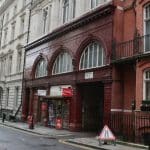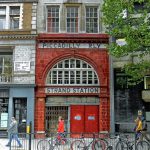Last Updated on 26/03/2023 by Alex Hamlyn
Table of Contents
Where is South Kentish Town Station?
A Love Affair with the London Underground
Ah, the London Underground! Known affectionately as “the Tube” by locals and history buffs like myself, this subterranean transportation marvel has always been a subject of fascination.
From its impressive 253-mile-long network to its role in London’s rich history, the Underground never ceases to amaze. So, let’s embark on a journey to one of its lesser-known, yet intriguing, stations: South Kentish Town.
Rolling Through the Northern Line
As one of the busiest lines on the Underground, the Northern Line has always held a special place in my heart. It’s like the overachieving sibling of the Underground family. Forming part of the original City & South London Railway, the Northern Line expanded over time, stretching across the capital from Morden to Edgware, High Barnet, and Mill Hill East.
Speaking of High Barnet, this particular branch is home to our mysterious station: South Kentish Town. Let’s delve into its history, shall we?
The Enigmatic South Kentish Town Station
South Kentish Town Station, formerly located at 145 Kentish Town Road, opened its doors on June 22, 1907, to an eager audience of commuters. The station’s architect, the ever-talented Leslie Green, designed it in his signature style, with ox-blood red glazed terracotta tiles adorning its exterior. It was a splendid sight, indeed!
Sadly, the station’s glory was short-lived, as it closed just 17 years later on June 5, 1924, due to low passenger usage.
But what makes South Kentish Town unique, you ask? Well, for starters, it’s one of the few “ghost stations” on the Underground. These abandoned stations, now devoid of passengers, are whispered to be haunted by the spirits of yesteryear. Spooky!
South Kentish Town: A Masterpiece of Architectural Design
The architectural prowess of South Kentish Town Station is certainly worth exploring. Leslie Green was responsible for designing numerous stations on the London Underground, most notably those on the Bakerloo, Piccadilly, and Northern lines.
His signature style is marked by the use of ox-blood red glazed terracotta tiles, which served both an aesthetic and functional purpose. The tiles not only created a striking appearance but were also easy to clean and maintain, a practical choice for the bustling Underground.
South Kentish Town’s construction included the use of steel framework and concrete floors, with large, semi-circular windows that allowed natural light to flood the interior. The platform walls were adorned with cream and green tiles, adding a touch of elegance and brightness to the subterranean space. The station also featured the iconic “bullseye” logo of the Underground, ensuring its unmistakable identity as part of the network.
Construction Challenges and Innovations
The construction of South Kentish Town Station, like many other Underground stations of its time, posed several engineering challenges. To build the station, workers had to tunnel through London’s clay soil, which was prone to collapsing. The use of the Greathead Shield, a revolutionary tunneling device, helped to overcome these difficulties. This innovative piece of equipment allowed workers to construct tunnels with minimal risk, ensuring the safety of both the laborers and the integrity of the station’s structure.
Moreover, the station’s construction required careful planning to minimize disruptions to the streets above. This involved coordinating the placement of support columns and working in confined spaces. The station’s design and construction were a testament to the ingenuity and perseverance of the engineers and workers who built the London Underground.
Wartime History: A Shelter from the Storm
During World War II, many of London’s Underground stations were repurposed as air-raid shelters, providing a safe haven for the city’s residents during the relentless bombings. South Kentish Town, despite its abandoned status, was no exception. The station’s platforms and tunnels were transformed into makeshift dormitories, complete with bunk beds, communal facilities, and even entertainment for the weary citizens seeking refuge.
The station’s shelter status is not only a fascinating aspect of its history but also a poignant reminder of the hardships faced by Londoners during the war. South Kentish Town and other stations like it played a vital role in protecting the city’s residents, providing comfort and security amidst the chaos above.
As the war progressed, the station’s strategic location and proximity to vital infrastructure made it an ideal location for storage and logistics. It’s said that the station housed essential supplies and equipment for use during the conflict. The station’s wartime history is a testament to the resilience and adaptability of the London Underground, which has always risen to the challenges of its time.
As for the question of touring the station, unfortunately, it’s not currently open to the public. However, the exterior of the station is still visible, and one can easily spot it on the corner of Kentish Town Road and Castle Road. At the time of writing, the original building is now home to a Breakout Room business. While not as exciting as a ghostly Tube station, I’m sure it has a few thrills of its own.
Neighbouring Stations and Ghostly Encounters
South Kentish Town lies between Kentish Town Station and Camden Town Station on the Northern Line. Despite its abandoned status, it shares some commonalities with other Underground stations, such as the architect Leslie Green’s distinctive designs, including Covent Garden and Oxford Circus stations.
As for supernatural tales, South Kentish Town is not the only station with a ghostly reputation. Take Aldwych Station, for example. Closed in 1994, this station is said to be haunted by the ghost of an actress who frequents the disused platforms. And let’s not forget the infamous British Museum Station, rumoured to be home to the spirit of an Egyptian mummy! Talk about ancient commuters!
Haunted and Abandoned: Underground Gems
South Kentish Town is just one of many intriguing abandoned stations on the London Underground. Other noteworthy examples include the aforementioned Aldwych Station, which has been featured in numerous films and television shows; Down Street, once frequented by Winston Churchill himself during World War II; and the ever-elusive “ghost platform” at King’s Cross St. Pancras, a source of endless curiosity for those who love a good mystery.
One can’t help but feel a sense of adventure when exploring these forgotten stations. Each one holds a piece of London’s history, just waiting to be rediscovered. From wartime bunkers to film sets and eerie ghost stories, the London Underground’s abandoned stations truly offer something for everyone.
The Supernatural Side of the London Underground
As a lover of the Tube’s history and its ghostly tales, I must say that the supernatural side of the Underground is particularly fascinating. Alongside South Kentish Town, Aldwych, and the British Museum stations, other locations with ghostly rumours include Bank Station, haunted by the “Black Nun” searching for her executed brother, and Liverpool Street Station, where the cries of children from a nearby burial ground are said to echo in the darkness.
The London Underground is not only an engineering marvel but also a treasure trove of myths, legends, and chilling stories. As we travel through its extensive network, we are not only riding the rails but also delving into the rich and captivating history of this great city.
The Ongoing Allure of South Kentish Town
While South Kentish Town Station may be closed to the public, its story continues to captivate the hearts and minds of those who love the London Underground. Its unique architecture, tales of wartime use, and ghostly status make it a truly unforgettable part of the Tube’s history.
So the next time you find yourself strolling through the streets of London or riding the Northern Line, take a moment to appreciate the historical wonders and supernatural mysteries that lie beneath your feet. From the long-forgotten South Kentish Town Station to the bustling platforms of King’s Cross, the London Underground is a testament to the city’s ever-evolving story.
As you can see, South Kentish Town Station, with its fascinating history and ghostly tales, is a perfect example of the many captivating stories hidden within the depths of the London Underground. It’s a love affair that will never end, and I, for one, couldn’t be more delighted.
Image credits
References
- https://en.wikipedia.org/wiki/South_Kentish_Town_tube_station


